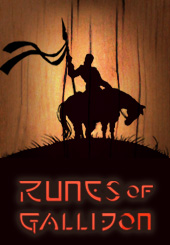A rune is magical sign or letter. It can be etched or inscribed on a variety of surfaces and objects. Anyone with the materials can depict runes - just as can be done with letters. Only adepts of the mystical art of Rune-weaving can imbue a rune with power - making it a magical rune.
The eighteen Runes Major are established. Runes Minor are far more numerous and have not been cataloged. Images of the Runes Major are available on the website.
A Rune-weaver placing runes upon an item (weapon, wall, gem, scroll, etc.) and imbuing them with power, in effect, creates a magic item (A cool example of a historical runic-weapon would be the Spearhead of Kovel).
The representative size of an enchanted rune has little to do with the power of that particular rune itself. The shape and form of the rune are what captures - focuses - contains the power therein. As long as the rune is clearly & properly inscribed - etched - depicted by an adept of the Rune-weaving craft, the power is imbued. It is the skill and power of the adept that informs the power of the enchanted rune. The physical size of the rune (be it major or minor) is strictly a style choice of the adept performing the ritual.
The finest swords forged in Mogadur, city of the Greater Noble House Kotar, masters of Construct, often feature a minor rune or two etched into the blade or tang, imbuing the blade with some mystical quality.
Imperial Roads are a prime example of "runic" structures. Constructed by House Kotar, warded against wear and the elements by House Morana, and Imperial Rune-weavers etching the appropriate runes into the very stones of the road and imbuing the magical powers of all three into a permanent state to create roads that are maintained without need of constant repair.
Step 1) House Kotar cut and arranged the stones, laying the path and physical structure of the road itself using their masonry and architectural skills enhanced by the mystical art of Constructs.
Step 2) House Morana created a Ward to protect the physical structure of the road against the elements/wear/time.
Step 3) Imperial Rune-weavers etched the runes of Constructs, Warding and the Emperor's Rune (Rune-weaving) onto stones of the road and made the magic permanent.
The Runes Major are most commonly seen as heraldic symbols for the Greater Noble Houses which are the acknowledged masters of the particular discipline displayed. The rune does NOT belong to the House. Rather, it represents a magical discipline. The Greater Noble Houses subtly attempt to lay claim to their particular magical discipline by incorporating the rune into their heraldry.
The Runes Major are typically reserved for the most powerful of spells within its discipline. Spells or effects of lesser magnitude are typically represented by Runes Minor.
Few boundaries are set for Runes Minor - they may represent specific effects-enchantments-spells or possibly a new discipline just being discovered and developed.
If one had a codex and the skill (Gift) to truly recognize the individual runes, one could guess with certitude what enchantment the item held. Uncertainty could arise from the arrangement of the runes in relationship to each other or the placement of the runes on the item, but the runes themselves could be identified with such a codex. An adept of Rune-weaving can typically make such an identification.
While there were rarely more than fifty Imperial Rune-weavers at any time (with three being Rune-weaving Masters), there are many individuals who have some grasp of the art of Rune-weaving. These non-Imperial Rune-weavers access and utilize Runes Minor with varying degrees of success. Attempts to use Runes Major by these individuals typically meet with tragic results. Runes Major were only known to be successfully used by Imperial Rune-weavers.
Minor enchantments on swords and armor, while unusual, are not unknown. Most cities (Mogadur is the most famed) have at least a few individuals familiar with the basics of Rune-weaving. Any item imbued with a powerful enchantment most likely came from the hands of an Imperial Rune-weaver or would be a relic from the Age of Disorder.
A rune can simply be a drawn symbol. Or it can contain, harness or release magical power if imbued by a Rune-weaver. Etched or inscribed upon an object by a Rune-weaver, it imbues, or enchants, the object with a magical power based upon the rune inscribed.
- Login to post comments



